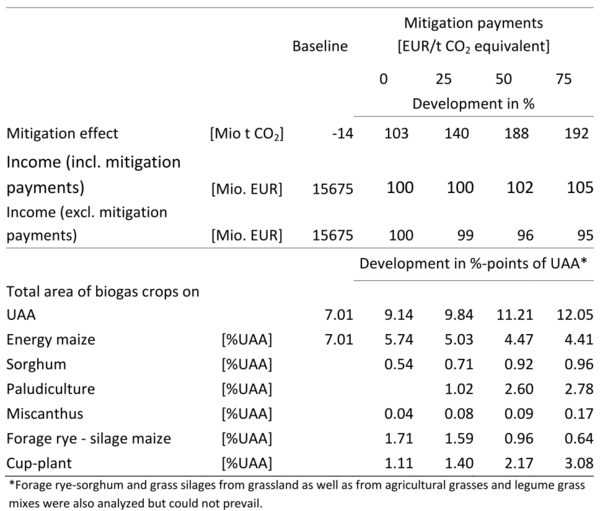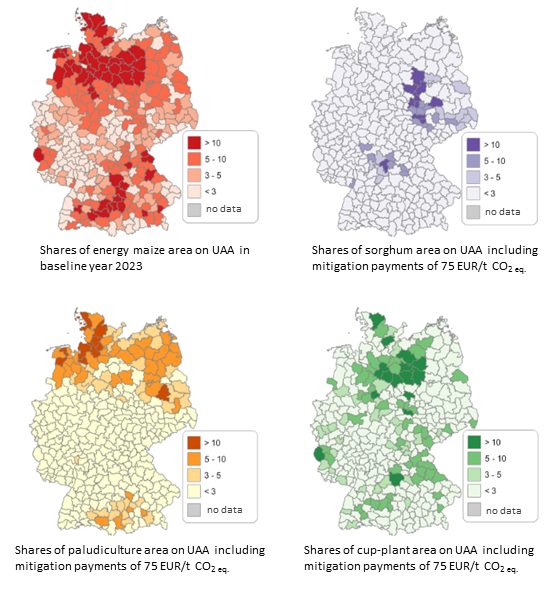Agricultural economics
Title of the subproject:
Model based impact analysis of agricultural land use strategies and land management systems to mitigate climate change and adapt to climate change
Introduction:
Agriculture is the most significant land user in Germany, comprising about 50 % of German land areas. The contribution of agricultural land use changes with regard to climate protection goals and possibilities available for agriculture to adapt to the expected climate change shall be studied and modelled in this subproject.
Institution:
Thünen Institute of Rural Studies
Aims
The aims of the subproject RAUMIS, in the context of the CC-LandStraD- Network project, with the help of the Regionalized Agricultural and Environmental Information System, RAUMISare:
- to analyse the impact of various developments in socio-economic framework conditions on agricultural land use, production and income as well as the green house gas emissions on the basis of various regions.
- to estimate the contribution of agriculture to climate protection and
- to study the impact of climate change on the planting of agricultural crops including the repercussions of the contribution to climate protection as well as possibilities to adjust land management to climate change.
Research approach and methods
To achieve the aims of the subproject RAUMIS, we are addressing the following scientific and technical key activities:
Integration of the regionalized agricultural sectoral model RAUMIS in an interdisciplinary model network for comprehensive and regionally differentiated modelling of the interactions between agricultural land use, production and greenhouse gas emissions as well as the adaptation of land use to climate change. These are broken down into the following steps:
- Implementation of selected production practices, technologies, farming systems and management strategies in RAUMIS with regard to the avoidance of greenhouse gas emissions and adaptation to climate change.
- Use of impact analyses with the help of a further developed RAUMIS model to answer questions in the thematic areas
- Study the impacts of various climate and economic framework conditions on agricultural land use, production, greenhouse gas emissions, nutrient losses, food and biomass production as well as on farm income.
- Contribute to innovative land management and farm strategies to attain reduced greenhouse gas emission goals.
- Strategies to adapt land management to climate change.
- Impact of various socio-economic framework conditions for and the consequences of the integration of climate protection goals in agricultural land use decisions.
- Preparation of the results for an evaluation of the trade-offs between a carbon-optimized land management in agriculture and other social demands on land use.
First results
Scenario simulations: Reducing maize cultivation by including alternative crops for biogas production
The agro-economic model RAUMIS was applied to simulate agricultural production methods providing biogas substrate. Beside the traditionally cultivated energy maize the following crops were considered: reed from paludiculture on rewetted fens, Miscanthus, cup-plant, sorghum, catch crop forage rye – sorghum, catch crop forage rye - silage maize, grass silages from grassland as well as from agricultural grasses and legume grass mixes.
The total area for biogas crops in the particular region was limited to 135 % of the expected energy maize area in 2023. Lower biomass and energy yields of the alternative biogas crops resulted partially in a need for larger areas to satisfy the demand for biogas from energy maize by the alternative crops. This area limitation also avoids an extension of the alternative biogas crops above the demand of the existing biogas plants and a too large reduction of areas used for food and fodder production. The subsidy policy scenarios consider mitigation payments paid for the emissions avoided with alternative biogas crops.
Results at sector level
Table 1 shows the results for emissions, income and production. The baseline scenario (year 2023) considers only energy maize. Four additional scenarios additionally contain bioenergy crops and mitigation payments. Without mitigation payments energy maize is predominantly substituted by forage rye – silage maize and cup-plant. The area used for biogas crop cultivation increases to more than 9 % of the utilized agricultural area (UAA) and the mitigation effect increases by 3 % due to fossil fuel substitution by energy from biomass. The agricultural income decreases with increasing biogas crop production as the alternative biogas crops have partially lower yields and substrate prices than energy maize or other cultivated crops. But taking mitigation payments of 25 €/tCO2 eq. into account, the income level can be retained whereat the mitigation effect increases by 40 %.
Mitigation payments of 25 €/t CO2 eq. and more led to an increase in cultivation area of sorghum, cup-plant and paludiculture at the expense of energy maize. GHG-emissions avoided by fen rewetting are credited to paludicultures as a mitigation effect. In connection with the mitigation payments, this assumption increases the competitiveness remarkably and paludiculture can prevail. Mitigation payments of 75 €/t CO2 eq. provoke an increase in the area used for biogas production by up to 12 % of the UAA dominated by paludiculture, cup-plant and energy maize. Sorghum, forage rye-silo maize and Miscanthus play only a minor role. Forage rye - sorghum as well as grass silages cannot prevail under the scenario conditions chosen, even if mitigation payments are high.

Results at regional level
Regional competitiveness towards other crops determines the distribution of alternative biogas crops. This is predominantly determined by the location-dependent regional yields and area potentials modeled.
Maps 1 to 4 represent the regional distribution of energy maize production in the baseline scenario as well as the distribution of cup-plant, sorghum and paludiculture under assumed subsidy policy with mitigation payments of 75 €/t CO2 eq..
Regarding the baseline scenario, energy maize production focuses predominantly on northwestern and southern Germany. Including a subsidy policy of 75 €/t CO2 eq. energy maize is mainly substituted by cup-plant and paludiculture (on fens) in northwestern Germany. It can be assumed that biogas plant capacities are greatest in these regions so that an extension of alternative biogas crops appears plausible. In southern Germany, paludiculture and cup-plant are less relevant for maize substitution, but is supplemented with sorghum and forage rye – silo maize (not shown).

(Maps 1 to 4 to download as pdf, not barrier free, 165 KB)
Discussion and outlook
Energy maize production is economically superior to alternative biogas crop cultivation. Only additional remuneration of CO2 mitigations caused by alternative biogas crops makes them - in dependence on the amount of mitigation payment- assertive. Crop specific demands in combination with regional agronomic conditions are decisive for the distribution of regional production focal areas of the crops according to their regional competitiveness.
Forage rye - sorghum and grass silages for biogas could not prevail under the assumed scenario conditions even if mitigation payments were high. The competitiveness of alternative biogas crops is determined by production costs, prices, biomass and energy yields as well as mitigation effects. Therefore, these assumptions have to be further discussed and considered when interpreting the scenario results.
The subsidy policy scenarios include mitigation payments that refer predominantly to mitigations by biogas crops due to fossil fuel substitution. For paludiculture, mitigations from fen rewetting were also included. Further subsidy policy scenarios could be analyzed including, for example, an area-based extensification payment for extensive permanent crops (paludiculture, Miscanthus, cup-plant).

